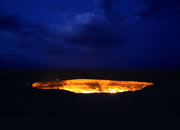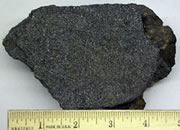Iratí Formation
Oil shale of the Permian Iratí Formation has the greatest potential for economic development because of its accessibility, grade, and widespread distribution. The Iratí Formation crops out in the northeastern part of the State of São Paulo and extends southward for 1,700 km to the southern border of Rio Grande do Sul into northern Uruguay. The total area underlain by the Iratí Formation is unknown because the western part of the deposit is covered by lava flows.
In the State of Rio Grande do Sul, the oil shale is in two beds separated by 12 m of shale and limestone. The beds are thickest in the vicinity of São Gabriel, where the upper bed is 9 m thick and thins to the south and east, and the lower bed is 4.5 m thick and also thins to the south. In the State of Paraná, in the vicinity of São Mateus do Sul-Iratí, the upper and lower oil-shale beds are 6.5 and 3.2 m thick, respectively. In the State of São Paulo and part of Santa Catarina, there are as many as 80 beds of oil shale, each ranging from a few millimeters to several meters in thickness, which are distributed irregularly through a sequence of limestone and dolomite.
Core drilling outlined an area of about 82 km2 that contains an oil-shale reserve of more than 600 million barrels
(about 86 million tons) of shale-oil equivalent, or about 7.3 million barrels/km2 near São Mateus do Sul in southern Paraná. In the San Gabriel and Dom Pedrito areas of Rio Grande do Sul, the lower bed yields about 7 weight percent shale oil and contains similar resources, but the upper bed yields only 2-3 percent oil and is not considered suitable for exploitation (Padula, 1969).
ADVERTISEMENT
The Iratí oil shale is dark gray, brown, and black, very fine grained, and laminated. Clay minerals compose 60-70 percent of the rock and organic matter makes up much of the remainder, with minor contributions of detrital quartz, feldspar, pyrite, and other minerals. Carbonate minerals are sparse. The Iratí oil shale is not notably enriched in metals, unlike marine oil shales such as the Devonian oil shales of eastern United States.
The origin of the Iratí Formation is controversial. Some researchers have concluded that the organic matter is derived from a predominantly algal/microbial source in a freshwater to brackish lacustrine environment as indicated by the geochemistry of the shale oil (Afonso and others, 1994). On the other hand, Padula (1969), quoting earlier researchers, hypothesizes that the organic-rich sediments were deposited in a partially enclosed intracontinental marine (Paraná) basin of reduced salinity that was in communication with the open sea. The basin formed after the close of Late Carboniferous glaciation. Hutton (1988) classified the Iratí oil shale as a marine oil shale (marinite).
Development of the Brazilian oil-shale industry began with the establishment of the Brazilian national oil company, Petrobras, in 1954. A division of that company, Superintendéncia da Industrialização do Xisto (SIX), was charged with the development of the oil-shale deposits. Early work concentrated on the Paraíba oil shale, but later focused on the Iratí shale. A prototype oil-shale retort and UPI (Usina Prototipo do Iratí) plant constructed near São Mateus do Sul began operations in 1972 with a design capacity of 1,600 tons of oil shale per day. In 1991 an industrial-size retort, 11 m in diameter, was put into operation with a design capacity of about 550 tons (~3,800 barrels) of shale oil per day. More than 1.5 million tons (~10.4 million barrels) of shale oil and other products including liquefied petroleum gas (LPG), methane, and sulfur have been produced from startup of the UPI plant through 1998.


















